Arguable beginning but Anthropocene definitely here
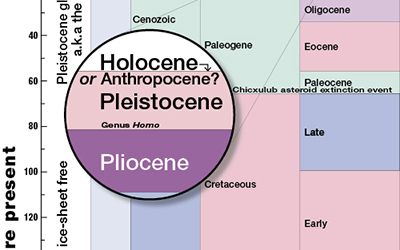
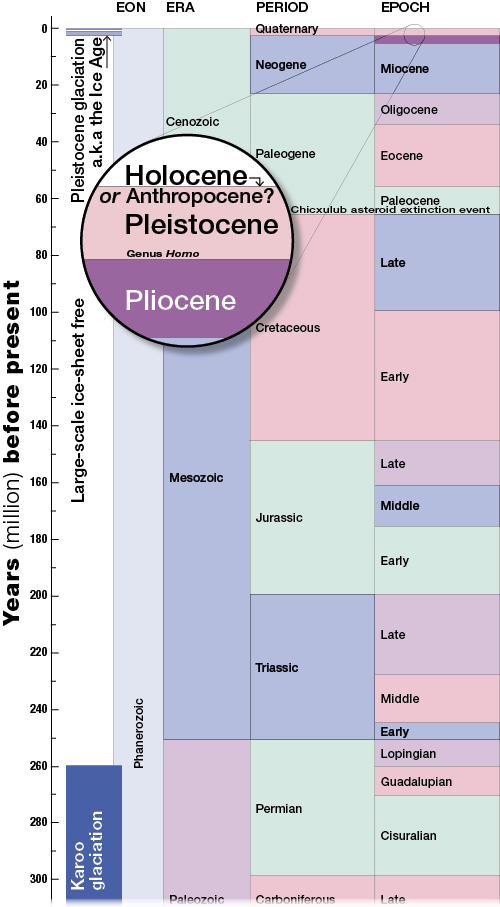
Like it Never Happened: Viewed at the scale of this most recent 7% of the Earth’s geologic time scale, the Holocene is too narrow to display. Epoch, notwithstanding the piddling Pleistocene and Pliocene, is used to denote periods of tens of millions of years. The solution, to the non-geologist, would appear simple. Replace it with the proposed Anthropocene, and commence that where human technology first left its geological mark, on the Australian continent by hunter-gathers 40 000 years ago. Note the rarity of glacial–interglacial periods, which is entirely typical of the Earth’s 4.54 billion year past. infographic Mahurangi Magazine
Cold has forever staked humanity. The Ice Age—or more formally, the Pleistocene glaciation—began 2.58 million years ago, and genus Homo just a whisker after that. Ostensibly, the Ice Age is ongoing, and the present interglacial period, during which Homo sapiens sapiens evolved, has already lasted a geologically generous 11 400 years. The prospect of another glaciation is a grim one for humanity, given how much more energy would be required to produce the requisite food, clothing and shelter for their recent durations of 40 000 to 100 000 years.
Ice ages are not the norm for planet Earth, which has for the most part been large-scale ice sheet –free. Ice ages, including interglacial periods such as that presently prevailing, total only about half a billion of the Earth’s 4.54 billion year existence. A rare combination of factors needs to align to precipitate an ice age, and Dr James Hansen states that human-generated greenhouse gases will now ensure that the glaciation that otherwise would have occurred, now won’t. The impact of even one chlorofluorocarbon factory, he estimates, would be sufficient to head off another glaciation. To boot, the sun is getting hotter. In one half to one billion years, water will no longer exist in liquid form on Earth, much less will ice sheets be able to develop.
Svante Arrhenius wrote in 1906 that the effect of the human emission of carbon dioxide was sufficiently strong to prevent the world from entering a new ice age. The physicist, not unreasonably for the time, believed this to be an entirely good thing. A century on however, that potentially good thing has become an exceedingly reckless trajectory that, unchecked, will see the oceans evaporated a billion years, give or take, ahead of time.
Next month in Beijing, the Atmospheric Chemistry in the Anthropocene conference:
…addresses the critical interactions between the atmosphere and human activities in an era where humans have fundamentally altered the composition and chemistry of our atmosphere.
The title of the event will raise the eyebrow of one or two stratigraphers, given that officially the Anthropocene doesn’t exist. The Holocene is the contemporary epoch, and it has, on a geological scale, barely begun. It’s a mere 11.4 thousand years old when the next shortest is the Pleistocene, at 2.588 million years. But so profound are anthropogenic changes on the atmosphere that mankind is leaving an indelible geological record. This includes wholesale species extinctions, the signature of nuclear weapon detonation, ocean acidification, sedimentation from deforestation and much more. And, as its usefulness in titling a conference on anthropogenic impacts on atmospheric chemistry illustrates, the term Anthropocene is here to stay.
It is likely that the Anthropocene era will be formalised, and not later than at the 2016 International Geological Congress. But between now and then, much deliberation will occur before a strong consensus emerges as to when it began. The essence of the Anthropocene, of course, is that point in the geological record that records the impact of Homo sapiens sapiens. In Australia this is apparent in the fossil record with the extinction, about 41 000 years ago, of megafauna the likes of the giant kangaroo. As elsewhere around the planet, these extinctions swiftly followed the arrival of human hunter-gatherers. But with a spread of 40 000 years between the extinctions in Australia and in Aotearoa, the absence of megafauna provides but a patchy reference point for stratigraphers.
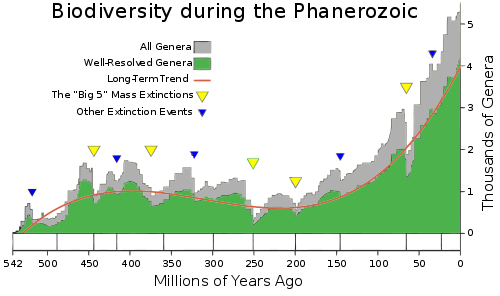
Abrupt Long-Term Landing: Coinciding with the commencement of the Anthropocene, biodiversity is plummeting, but on the scale of this chart has yet to register. The long-term trend line here nicely distracts the eye from the radical biodiversity nosedives of the past. The Cretaceous–Paleogene extinction event caused by Chicxulub asteroid, which did for the dinosaurs, is the most recent of the ‘big five’ extinction events, at the 65.5 million year mark. Tragically, the anthropogenic species loss is likely to be every bit as abrupt as that caused by a 15-kilometre-wide asteroid. chart Wikipedia
Stratigraphers, unsurprisingly, love to have an indelible stratigraphic reference point on which to base an epoch. A hefty asteroid impact, leaving as it does an unmistakable layer of ‘shocked’ quartz around the world. Ironically, it was the dinosaur extinction layer that initially got to define the end of the Cretaceous period, rather than the direct evidence of the impact that caused them.
The first similarly unambiguous and ubiquitous record left by humans was by its nuclear weapons:
Some geologists argue that the bomb pulse would be the best candidate for the official stratigraphic boundary of the Anthropocene. It’s unambiguous, global, and sharp.
Given that human activity, in all probability, has seen off the ice ages, it is arguable the Anthropocene should be seen as the beginning of the 11th era—the Anthrozoic. But hell-bent on its business-as-usual path, if humanity does unleash, or has already unleashed, runaway global warming, it would not merely be end of a geological era, so much as end of an eon. The current eon, the Phanærozoic, has seen Earth’s greatest ever explosion of biodiversity. A subsequent final lifeless eon would need a suffix other than –zoic—possibly the Eschateon, to avoid anything more macabre.
Because there is everything to play for, Anthrozoic is premature, and Anthropocene, even before becoming official, is proving useful in focussing minds on the unprecedented challenge facing the 10 001st human generation. During the Cold War, humanity stared into the abyss of extinction. But although a nuclear winter would have diabolical consequences for the human species, and for perhaps a majority of species, life itself would not have been extinguished with the finality threatened by runaway global warming. The term Anthropocene was coined in the early 1980s by the late Dr Eugene Stoermer, a leading researcher in diatoms, with much of his work focussed on the Great Lakes. It was adopted by a number of scientists but it didn’t enter the limelight until promoted by atmospheric chemist Professor Paul Crutzen in 2000, who had received the Nobel Prize five years earlier for his work on the hole in the ozone layer.
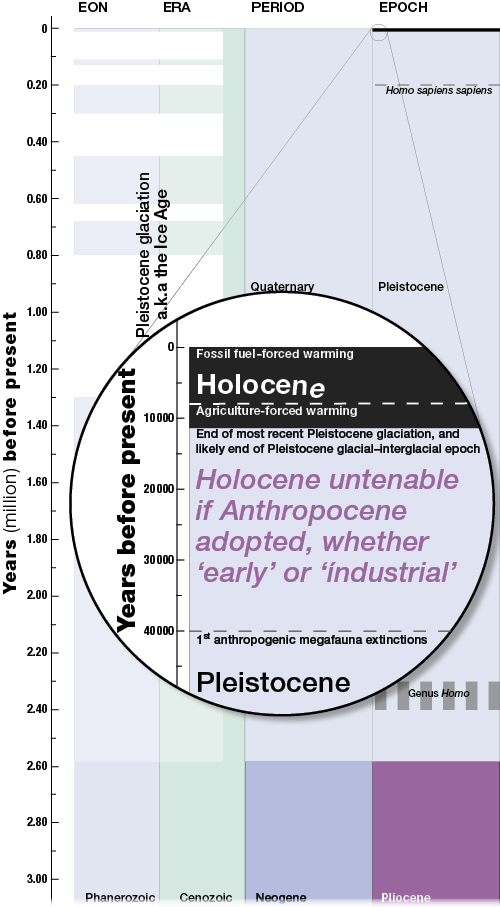
Interglacial that Isn’t: Had it not serendipitously proved to be the end of the Pleistocene glaciation, the establishment of the Holocene epoch would have remained without merit. Because anthropogenic global warming rules a firm line across the end of the ‘Ice Age’, the Earth is now in a post-glaciation period, rather than an interglacial. The stratigraphers, in 1885, appear to have been right for the wrong reason. Agriculture, even by 8000 years before the present, probably rendered further glaciation unlikely—palaeoclimatologist Professor William Ruddiman argues for the ‘early Anthropocene.’ infographic Mahurangi Magazine
Growing up in the aftermath of the Third Reich, many baby boomers must have pondered the reality of those caught up in its atrocities. Some were provoked by reading, perhaps at too tender an age, the deeply disturbing Auschwitz, written by the Dr Miklos Nyiszli, a Jewish victim who served in the piteous Sonderkommando. Or particularly by the book’s since disparaged foreword by Professor Bruno Bettelheim, which largely blames a business-as-usual mindset of Jews for their genocide—Jews were given every encouragement to leave Germany, as he did, he argues.
The millions currently dying due to anthropogenic global warming, and the billions immediately at risk, parallels in magnitude the 11–17 million victims of various ethnicities of the Nazi genocide. Many global warming victims approach the utter powerlessness of the vast majority of the Nazi’s victims. Others, the majority of informed adults alive today, are complicit in global warming but far from at gunpoint. Granted, political parties are frequently bought and paid for by the fossil-fuel oligarchy but, in most regions of the world, speaking out against this is less than life threatening. However, democracy is effectively owned by big business, and little progress is possible without state-funded elections, and without global democracy.
Mainstream media so completely immerses the masses in a comforting illusion of normalcy, that few political parties—in Aotearoa all but the tiny Workers Party—risk ruffling feathers by making policy to head off the impending holocaust. Labour’s economic development spokesman David Cunliffe has spoken powerfully about global warming, and of population, but rather than that result in the moral issue of the 21st century promptly shaping party policy, a messy attempt was made to force his resignation. It is imperative that a major party steps up to provide leadership, as Aotearoa is swept into the narrowing canyon of climate catastrophe.
Canyons, of course, are also a stratigrapher’s wet dream—the Grand Canyon exposes strata spanning 1.84 billion years. But if the world’s stratigraphers are to contribute to public’s understanding of the enormity of anthropogenic impact, a few of their toes will need to be trodden on if the famously glacial process of establishing new geological periods of time is to be improved on. The most recent epoch agreed upon is the Holocene. First proposed in 1885, it wasn’t until 1967 that the United States Geological Survey formally adopted the term, in preference to Recent. From the Greek ‘entirely recent’, it follows a succession of epochs unfortunately named by the great Sir Charles Lyell that were characterised by the equally great Henry Watson Fowler, lexicographer, as ‘regrettable barbarisms’. Barbaric and banal—working back from ‘entirely recent’ is ‘most new’, ‘more new’, ‘less new’ and ‘few new’. It is not until ‘dawn new’, referring to the dawn of modern mammalian fauna, that the epochs start attract some halfway descriptive names.
What might be considered even more barbaric than Sir Charles’s nomenclatural legacy, however, is to devalue stratigraphy lexicon by creating an epoch of little more than 10 000 years. To date, the term applied not to tens of thousands of years, but to tens of millions of years. If the Holocene was terminated to allow the Anthropocene to begin, the slither of time it represented could not be thought of as an epoch—an age at best.
The concept of the Anthropocene was coined:
…to refer to the impact and evidence for the impact of human activities on the planet earth.
By appropriating Anthropocene, Professor Crutzen was keen to focus attention on changes to the atmosphere. But if the concept of the epoch was allowed to revert to Dr Stoermer’s original definition, its power to communicate the big picture of anthropogenic impact would be enhanced. Humans, first by sending megafauna extinct, through deforestation, through agriculture, have been changing the landscape, the weather and geology since late in the Pleistocene—possibly 30 000 years before the ‘entirely recent’ Holocene began. The solution, at least to non-stratigraphers, seems straightforward. Dispense with the Holocene, tentatively commence the Anthropocene to reflect the Australian stratigraphic record, and create a new age, say the Anthropoian, to mark the beginning of the industrial age—when, in the late 1700s, a carbon-dioxide pulse records where anthropogenic global warming kicked into top gear.
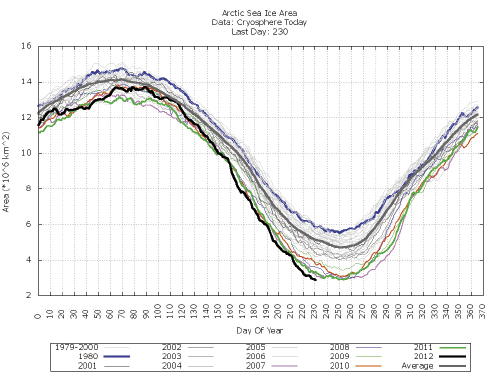
Anthropocene Evident in Arctic: Evidence abounds as to Homo sapiens sapiens having, in all probability, seen off the last of the Pleistocene glaciation, including from this Arctic sea ice area satellite data, as at 17 August 2012. chart Cryosphere Today
If indeed, Homo sapiens sapiens has succeeded in seeing off the Pleistocene glaciation, then a new period could be imposed, the Anthroene, to take over from the Quaternary. By then, there will probably be no argument that the beginning of the Anthropocene was also the end of an era, and an Anthropozoic would share that point in Earth’s history that records when a single single-minded species first developed the technology to leave an increasingly graphic geological footprint.
So while it is debateable as to when it began, an official Anthropocene is coming, but surely the world should not have to wait until 2016, for the International Geological Congress to act.
May history record that the world’s stratigraphers stepped up to play their part in the now massively overdue global warming mobilisation.
